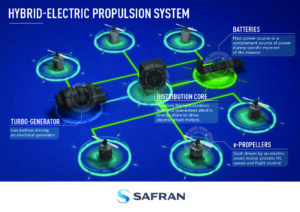 This week at AUVSI’s Xponential, Textron company Bell Helicopters showed off a prototype of an urban air mobility vehicle – a drone taxi – and we’d ride in one without hesitation.
This week at AUVSI’s Xponential, Textron company Bell Helicopters showed off a prototype of an urban air mobility vehicle – a drone taxi – and we’d ride in one without hesitation.
First introduced at this year’s consumer electronics show (CES), the BellNexus is definitely in the prototype stage, although staff siad that they hope to have one in the air within the next year or two. What the prototype does, however is to show off the collaborative ideas that may make the idea of urban air transport realistic.
For one thing, this prototype has a pilot seat. While the automation technology exists, the industry recognizes that the populace may not be quite ready to get into a machine that will lock the doors and take off by itself – so in this phase, the vehicles may not be unmanned.
Additionally, the prototype introduces the type of engines that may be used to power air mobility vehicles. In this case, the engine is a hybrid propulsion system.
Around the world, urban air mobility has become a hot topic, as cities realize that their ability to expand ground transportation is constrained. There may be, quite literally, nowhere to go but up in order to solve some cities’ traffic problems.
The first drone taxi was put into operation in Dubai in 2017. On-demand transportation company Uber has said that they are actively working on urban air mobility and that Los Angeles will be their second test site.
The following is taken from a Bell Helicopter press release.
 CES 2019 – Las Vegas (Jan. 7, 2019) – Bell Helicopter, a Textron Inc. (NYSE: TXT) company, revealed the configuration and full-scale vertical-takeoff-and-landing (VTOL) air taxi vehicle today during CES 2019. The air taxi, named Bell Nexus, is powered by a hybrid-electric propulsion system and features Bell’s signature powered lift concept incorporating six tilting ducted fans that are designed to safely and efficiently redefine air travel.
CES 2019 – Las Vegas (Jan. 7, 2019) – Bell Helicopter, a Textron Inc. (NYSE: TXT) company, revealed the configuration and full-scale vertical-takeoff-and-landing (VTOL) air taxi vehicle today during CES 2019. The air taxi, named Bell Nexus, is powered by a hybrid-electric propulsion system and features Bell’s signature powered lift concept incorporating six tilting ducted fans that are designed to safely and efficiently redefine air travel.
BELL NEXUS
“As space at the ground level becomes limited, we must solve transportation challenges in thevertical dimension – and that’s where Bell’s on-demand mobility vision takes hold,” said Mitch Snyder, president and CEO, Bell. “The industry has anticipated the reveal of our air taxi for some time, so Bell is very proud of this moment. We believe the design, taken with our strategic approach to build this infrastructure, will lead to the successful deployment of the Bell Nexus tothe world.”
Bell Nexus means the nexus of transport and technology and of comfort and convenience. Nexus captures the long-sought-after vision of quick air travel with a unique in-flight experience, keeping passengers connected to their lives and saving valuable time.
Team Nexus, consisting of Bell, Safran, EPS, Thales, Moog and Garmin, are collaborating onBell’s VTOL aircraft and on-demand mobility solutions. Bell will lead the design, development and production of the VTOL systems. Safran will provide the hybrid propulsion and drive systems, EPS will provide the energy storage systems, Thales will provide the Flight Control Computer (FCC) hardware and software, Moog will develop the flight control actuation systems and Garmin will integrate the avionics and the vehicle management computer (VMC).

Miriam McNabb is the Editor-in-Chief of DRONELIFE and CEO of JobForDrones, a professional drone services marketplace, and a fascinated observer of the emerging drone industry and the regulatory environment for drones. Miriam has penned over 3,000 articles focused on the commercial drone space and is an international speaker and recognized figure in the industry. Miriam has a degree from the University of Chicago and over 20 years of experience in high tech sales and marketing for new technologies.
For drone industry consulting or writing, Email Miriam.
TWITTER:@spaldingbarker
Subscribe to DroneLife here.







[…] Source link […]